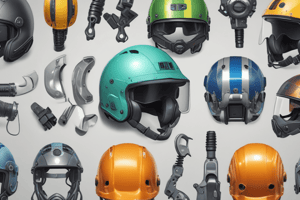Podcast
Questions and Answers
An athlete with a history of head trauma insists on using a vintage helmet that visually appears to be in good condition but lacks current certification. What is the most ethically sound and practically justifiable course of action, assuming a duty of care and an understanding of biomechanical principles?
An athlete with a history of head trauma insists on using a vintage helmet that visually appears to be in good condition but lacks current certification. What is the most ethically sound and practically justifiable course of action, assuming a duty of care and an understanding of biomechanical principles?
- Permit its use only during low-impact training drills to mitigate potential harm, contingent upon the athlete demonstrating proficiency in self-protective techniques.
- Recommend a comprehensive biomechanical analysis of the helmet's impact absorption capabilities by a certified laboratory to ascertain its protective efficacy prior to any use.
- Allow the athlete to use the helmet after signing a waiver acknowledging the risks, thus respecting their autonomy while transferring liability.
- категорично відмовити у використанні шолома через відсутність сертифікації, надаючи детальне пояснення щодо обмежень у захисті від травм голови. (correct)
In the context of fitting a football helmet, which of the following scenarios necessitates the most immediate and critical adjustment to ensure optimal protection against axial loading and rotational forces?
In the context of fitting a football helmet, which of the following scenarios necessitates the most immediate and critical adjustment to ensure optimal protection against axial loading and rotational forces?
- The helmet, when properly fastened, consistently shifts more than one inch in any direction during vigorous head rotation exercises. (correct)
- There is a palpable gap between the anterior portion of the helmet padding and the athlete's forehead when subjected to lateral acceleration.
- The chin strap system, despite being correctly adjusted, exhibits a degree of elasticity exceeding 15% under maximal voluntary isometric contraction of the jaw muscles.
- The athlete reports mild discomfort along the occipital ridge after several minutes of simulated gameplay.
What specific communication strategy most effectively balances the imperative of educating an athlete about the limitations of helmet certification with maintaining their trust and adherence to safety protocols?
What specific communication strategy most effectively balances the imperative of educating an athlete about the limitations of helmet certification with maintaining their trust and adherence to safety protocols?
- Presenting statistical data illustrating the correlation between helmet age, impact frequency, and structural degradation, emphasizing the probabilistic nature of protection.
- Employing a comparative analysis of various helmet brands and certification bodies, overtly critiquing the discrepancies in testing methodologies and marketing claims.
- Framing certification as a baseline standard, elucidating that it does not guarantee immunity from injury but signifies compliance with minimum safety requirements under ideal conditions. (correct)
- Describing graphic case studies of athletes who sustained severe head injuries despite wearing certified helmets, highlighting instances of equipment failure and misuse.
During a pre-fitting assessment, an athlete discloses experiencing persistent paresthesia in the temporomandibular joint (TMJ) region following previous helmet use. Beyond standard fitting procedures, what specialized evaluation should be prioritized to mitigate potential exacerbation of this condition?
During a pre-fitting assessment, an athlete discloses experiencing persistent paresthesia in the temporomandibular joint (TMJ) region following previous helmet use. Beyond standard fitting procedures, what specialized evaluation should be prioritized to mitigate potential exacerbation of this condition?
Considering the biomechanical factors involved in head injuries, what is the most critical rationale for ensuring a snug helmet fit in activities involving rapid deceleration and high angular velocities?
Considering the biomechanical factors involved in head injuries, what is the most critical rationale for ensuring a snug helmet fit in activities involving rapid deceleration and high angular velocities?
Considering the biomechanical implications of shoulder pad design in high-impact sports, which of the following modifications would most effectively mitigate the risk of axial loading injuries to the cervical spine during helmet-to-shoulder tackling, assuming a constant head-neck stiffness?
Considering the biomechanical implications of shoulder pad design in high-impact sports, which of the following modifications would most effectively mitigate the risk of axial loading injuries to the cervical spine during helmet-to-shoulder tackling, assuming a constant head-neck stiffness?
In the context of athletic equipment maintenance, and given the principles of materials science, which degradation mechanism would pose the most significant long-term threat to the structural integrity of a cantilever shoulder pad's composite material, assuming repeated exposure to elevated temperatures and ultraviolet (UV) radiation?
In the context of athletic equipment maintenance, and given the principles of materials science, which degradation mechanism would pose the most significant long-term threat to the structural integrity of a cantilever shoulder pad's composite material, assuming repeated exposure to elevated temperatures and ultraviolet (UV) radiation?
Considering the ethical implications of protective equipment design in sports, which preemptive measure should an equipment manufacturer prioritize to mitigate potential liability arising from the misuse of shoulder pads as offensive weapons, despite their primary function being protective?
Considering the ethical implications of protective equipment design in sports, which preemptive measure should an equipment manufacturer prioritize to mitigate potential liability arising from the misuse of shoulder pads as offensive weapons, despite their primary function being protective?
Given a scenario where an athlete exhibits restricted glenohumeral joint range of motion during shoulder pad fitting, and assuming that standard sizing protocols have been followed, which of the following biomechanical adaptations is most likely to compensate for this limitation, potentially increasing injury risk?
Given a scenario where an athlete exhibits restricted glenohumeral joint range of motion during shoulder pad fitting, and assuming that standard sizing protocols have been followed, which of the following biomechanical adaptations is most likely to compensate for this limitation, potentially increasing injury risk?
An athlete reports that their shoulder pads, fitted according to manufacturer guidelines, consistently impinge on the axillary nerve during abduction and external rotation of the arm. What modification to the pad design would MOST effectively address this issue while maintaining adequate protection and range of motion?
An athlete reports that their shoulder pads, fitted according to manufacturer guidelines, consistently impinge on the axillary nerve during abduction and external rotation of the arm. What modification to the pad design would MOST effectively address this issue while maintaining adequate protection and range of motion?
An elite neurotrauma research team seeks to design a novel helmet testing protocol that more accurately predicts concussion risk in vivo, acknowledging the limitations of current impact absorption tests. Which of the following approaches would represent the most significant advancement beyond existing methodologies?
An elite neurotrauma research team seeks to design a novel helmet testing protocol that more accurately predicts concussion risk in vivo, acknowledging the limitations of current impact absorption tests. Which of the following approaches would represent the most significant advancement beyond existing methodologies?
In a scenario where a high school football team's budget is severely constrained, and multiple helmets exhibit signs of wear, what is the most ethically and practically sound triage strategy for equipment management, prioritizing player safety while adhering to limited resources?
In a scenario where a high school football team's budget is severely constrained, and multiple helmets exhibit signs of wear, what is the most ethically and practically sound triage strategy for equipment management, prioritizing player safety while adhering to limited resources?
Given the inherent limitations of current helmet technology in preventing concussions, what comprehensive strategy would a multidisciplinary team (including coaches, medical staff, and equipment managers) implement to minimize concussion risk and promote a culture of safety within a football program?
Given the inherent limitations of current helmet technology in preventing concussions, what comprehensive strategy would a multidisciplinary team (including coaches, medical staff, and equipment managers) implement to minimize concussion risk and promote a culture of safety within a football program?
Considering the ethical complexities surrounding the marketing and endorsement of football helmets, particularly claims regarding concussion prevention, what standard should govern manufacturer communications to ensure consumer understanding and prevent potentially misleading information?
Considering the ethical complexities surrounding the marketing and endorsement of football helmets, particularly claims regarding concussion prevention, what standard should govern manufacturer communications to ensure consumer understanding and prevent potentially misleading information?
You are tasked with developing a cutting-edge, AI-driven system for real-time concussion detection on the field during a football game. Which combination of sensor modalities and analytical techniques would provide the highest sensitivity and specificity, while minimizing false positives and respecting athlete privacy?
You are tasked with developing a cutting-edge, AI-driven system for real-time concussion detection on the field during a football game. Which combination of sensor modalities and analytical techniques would provide the highest sensitivity and specificity, while minimizing false positives and respecting athlete privacy?
In a scenario where a college football player with a history of multiple concussions is determined to continue playing despite medical advice recommending retirement, what is the ethical responsibility of the team physician, and what steps should be taken to balance athlete autonomy with the physician's duty of care?
In a scenario where a college football player with a history of multiple concussions is determined to continue playing despite medical advice recommending retirement, what is the ethical responsibility of the team physician, and what steps should be taken to balance athlete autonomy with the physician's duty of care?
A leading helmet manufacturer discovers a latent defect in a batch of recently produced helmets that could compromise their protective capacity under specific high-impact conditions, although the helmets still meet minimum certification standards. What is the most ethically responsible course of action for the manufacturer?
A leading helmet manufacturer discovers a latent defect in a batch of recently produced helmets that could compromise their protective capacity under specific high-impact conditions, although the helmets still meet minimum certification standards. What is the most ethically responsible course of action for the manufacturer?
Considering the increasing awareness of chronic traumatic encephalopathy (CTE) and its potential link to repetitive head impacts in football, how should equipment managers balance the need for functional and protective equipment with long-term player health and safety, especially in the absence of conclusive evidence directly linking helmet design to CTE prevention?
Considering the increasing awareness of chronic traumatic encephalopathy (CTE) and its potential link to repetitive head impacts in football, how should equipment managers balance the need for functional and protective equipment with long-term player health and safety, especially in the absence of conclusive evidence directly linking helmet design to CTE prevention?
Flashcards
Helmet Fitting Importance
Helmet Fitting Importance
Proper helmet fitting is crucial to prevent head injuries and ensure comfort.
Guidelines for Fitting
Guidelines for Fitting
Follow manufacturer instructions, check for snug fit, and inspect the helmet's condition.
Head Circumference Measurement
Head Circumference Measurement
Measure head circumference 1 inch above the eyebrows for fitting.
Inspecting Helmets
Inspecting Helmets
Signup and view all the flashcards
Asking Pre-Fitting Questions
Asking Pre-Fitting Questions
Signup and view all the flashcards
Shoulder Pad History
Shoulder Pad History
Signup and view all the flashcards
Athlete Position Importance
Athlete Position Importance
Signup and view all the flashcards
Testing Game Movement
Testing Game Movement
Signup and view all the flashcards
Shoulder Pad Condition Check
Shoulder Pad Condition Check
Signup and view all the flashcards
Pad Coverage Check
Pad Coverage Check
Signup and view all the flashcards
Helmet Maintenance
Helmet Maintenance
Signup and view all the flashcards
Crack Inspection
Crack Inspection
Signup and view all the flashcards
Connective Hardware
Connective Hardware
Signup and view all the flashcards
Corrosion Check
Corrosion Check
Signup and view all the flashcards
Warning Label
Warning Label
Signup and view all the flashcards
Concussion Symptoms
Concussion Symptoms
Signup and view all the flashcards
Fit Examination
Fit Examination
Signup and view all the flashcards
Cleaning Protocol
Cleaning Protocol
Signup and view all the flashcards
Study Notes
Helmet Fitting
- Head injuries are a significant concern in contact sports, and helmets are crucial for protection
- Proper fitting is essential for safety and comfort
- Visibility, hearing, and comfort should be considered during fitting
- Educating athletes about proper helmet use is crucial to safety
- Inspecting helmets (new or used) and ensuring they meet current certification standards is important
- Cleanliness and sanitation of equipment are key considerations
- Having confidence in advising athletes on helmet fitting is valuable.
Helmet Fitting - Guidelines
- Understand and follow manufacturer's instructions for helmet safety.
- Visually Inspect helmets, both new and previously used/reconditioned.
- Ensure hair and head's condition mimic sweat, by wetting hair and head prior to fitting.
- Measure head circumference 1 inch above the eyebrow.
- Ensure helmet is fitted correctly and snug
- Check height and bladder change (altitude related) for proper fit
- Chin straps must be inspected and adjusted using 2, 4, or 6 strap systems.
- Inspect and ensure jaw pads are present (football, and occasionally missing)
- Routinely check the fit to ensure proper function.
Helmet Fitting - Athlete Assessment
- History of head trauma
- Previous experience with helmets
- Light sensitivities (need for visors)
- Player position (cage/visor considerations)
- Appropriate helmet selection for playing level.
- Evaluate if street hockey goalie helmets are appropriate for minor hockey.
Helmet Maintenance
- Regularly examine helmets before and after each game
- Any helmet cracks require immediate discarding
- Examine and tighten all hardware
- Fix, replace or discard rusted/worn nuts and bolts.
- Conduct thorough corrosion checks at the end of each season.
Helmet Maintenance - Additional Considerations
- Examine condition of protective cage/visor
- Inspect straps and locking clips that secure helmet in place
- Periodically check helmet fit on player's head
- Clean helmets at least once per season
- Ensure appropriate warning stickers/certification stickers are present.
Helmet Function and Importance
- Scientists disagree on how impact absorption tests relate to concussion risk reduction.
- No helmet system can prevent concussions or eliminate serious head/neck injuries in contact sports
- Athletes should not butt, ram, spear, or strike opponents with helmets or faceguards
- Severe brain or neck injuries are possible during collisions.
- Report symptoms immediately (loss of consciousness, memory loss, dizziness, headache, nausea, or confusion) to coaches, trainers and parents. Do not return to play without clearance.
- Seek appropriate medical clearance.
Helmet Specifics
- Some programs (certain leagues) use 3D imaging for custom helmet fitting.
How to Make Helmets Team-Specific
- Albany FireWolves, ND Fighting Irish, and possible other programs are creating helmets with team-specific features (extra protection, player feedback, cost factors).
Shoulder Pad Fitting
- Consider the athlete's past injuries (shoulder, ribs, clavicle etc)
- Follow standardized measurement guidelines to ensure a snug fit, consider position-specific measurements
- Determine the athlete's playing position for proper sizing.
- Have the athlete perform game movements to ensure proper pad fit during movement
- Neck and shoulder adjustments must allow for complete freedom of arm movement.
Shoulder Pad Fitting - Guidelines
- Outer pad should cover shoulder tip and lateral aspect.
- Ensure cantilever is properly aligned and padded.
- Make sure epaulets and cups properly cover the deltoid and shoulder
- Pad functionality (hockey players) does not affect elbow pads
- Check the front and back of pads, and adjust fit as needed.
- Assess if the pads need additional padding.
Shoulder Pad Maintenance
- Examine outer shell condition before and after each game.
- Replace cracked pads, or discontinue use of damaged or cracked pads.
- Check straps and locking clips that hold pads securely in place
- Inspect the foam liner for rips or tears.
General Information
- Equipment protection: face masks and shoulder pads mitigate the amount of contact absorbed during play.
- Risk of injury: using the equipment in an unsafe manner may lead to injury.
- Situations: Helmet/pad use is important in the heat of sports, so athletes may use the protective features.
Studying That Suits You
Use AI to generate personalized quizzes and flashcards to suit your learning preferences.




